Español
Okinawa, the other side of Japan

Welcome to Okinawa, Japan's subtropical archipelago. For Latin American travelers, this destination offers the best of Asia with a unique identity: Caribbean-like vibes, a rich history, unique cuisine (try the goya champuru or the agu pork!), and a warm hospitality that will make you feel right at home. Why visit Okinawa? Because there's more there than just You'll see destinations, live authentic experiences: diving among coral reefs, walks through sacred forests, and sunsets that look like they're straight out of a painting. Don't know where to start? Join me as we explore this island region by region.
Northern Okinawa:
Your adventure begins in the north, a world of emerald jungles and dramatic coastlines.
Kouri Island and Heart Rock (古宇利島):
Drive across the 2-km Kouri Bridge, feeling as if you're floating above the sea. On the island, look for Heart Rock (ハートロック), a natural rock formation that emerges from the water at low tide, a symbol of the "Island of Love." It's a place you can visit completely free of charge, and the best time is at sunrise or sunset for golden photos and fewer crowds. The crystal-clear water is ideal for snorkeling among tropical fish.
Best time to visit?:
Spring (March-May) or autumn (September-November) if you are looking for pleasant weather and fewer crowds than in summer.

Okinawa Churaumi Aquarium (沖縄美ら海水族館):
In Motobu, this gigantic aquarium will mesmerize you with its main tank, "Kuroshio," one of the largest in the world. There, you can watch majestic whale sharks (nearly 9 meters long!) and manta rays swim by. The displays of live corals cultivated here are unique.
Opening hours: Open all year round from 8:30 to 20:00 (entry until 19:00).
Tip: Go early in the morning or after 4:00 PM to avoid crowds. Nearby, you'll find Sesoko Beach, which offers white sand and calm waters ideal for swimming afterward.
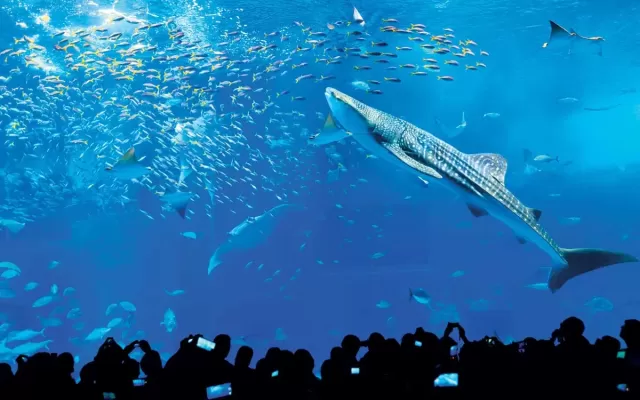
Hiji Waterfall (比地大滝):
If you're an adventurer or a nature lover, this is the destination for you! Venture into the Yambaru jungle. After paying the entrance fee at the trailhead, you'll hike 1.5 km (approximately 40 minutes) through a lush forest, where you'll also have the opportunity to cross a suspension bridge. The reward is Okinawa's tallest waterfall (26 meters), a haven of tranquility.
Hours: Daytime access, but arrive early to enjoy the cool morning air and light. It's best to go during the rainy season (May-June) when the water flow is most impressive, or in autumn if you prefer cooler temperatures.

Okinawa Central:
The center is the vibrant heart, perfect for families and those seeking variety.
Busena Marine Park (ブセナ海中公園):
In Nago, you literally walk underwater. The underwater walkway with glass windows lets you see reef fish without getting wet. Glass-bottom boat tours are also available. Opening hours: Generally 9:00 AM - 6:00 PM. Ideal for hot days or if you don't dive.
Kaichu-doro Highway (海中道路):
If you have a driver's license, renting a car is an excellent option, and you can drive along this incredible 5-km road that cuts through the turquoise sea, connecting small islands. You can stop at the side beaches along the way, such as Hamahiga or Miyagi, for a quick dip and to take panoramic photos. It's free and accessible 24/7, but the best time is during strong sunlight (midday) to appreciate the blue color in all its glory.
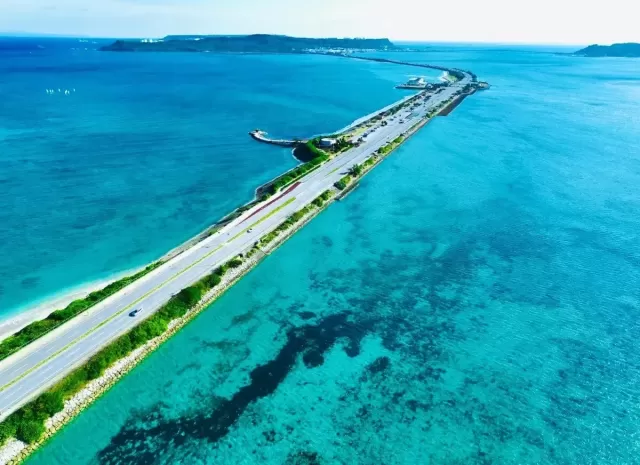
Mihama American Village (美浜アメリカンビレッジ):
Near Kadena Air Base, this American-style theme park is bustling with souvenir shops, restaurants (from burgers to ramen), and music. It's especially magical at dusk with the lights. Ideal for shopping and dining. Open all day, although the shops usually close at 9 pm.

Southeast Botanical Gardens (東南植物楽園):
A tropical oasis with thousands of plants, giant palm trees (walk along the 25-meter-tall avenue of palm trees!), exotic flowers, and animals like iguanas. In season (usually winter), they have spectacular nighttime illuminations.
Opening hours: 9:00 - 18:00 (lighting until later). Perfect refuge for cloudy or rainy days.
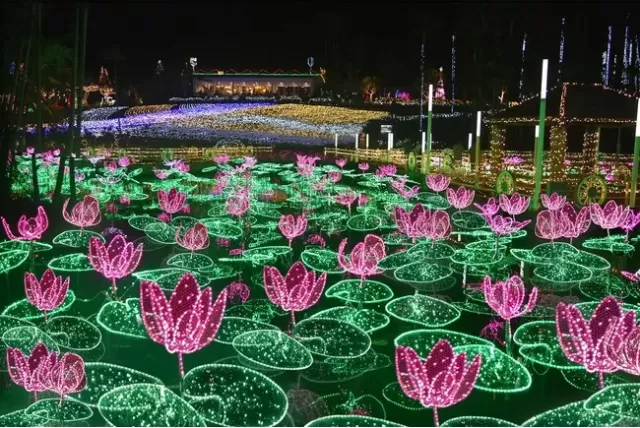
Southern Okinawa:
Here beats the ancient soul of Okinawa, the Ryukyu kingdom.
Shuri Castle (首里城):
Stroll through the reconstructed (1992) Ryukyu Kings' Royal Palace. Admire the unique architecture, a blend of Chinese and Japanese influences, with its distinctive red roofs and guardian Shisa lions. Although a fire in 2019 damaged major areas, the park and some structures remain open.
Opening hours: 8:00 - 18:30 (last entry at 18:00). Go early to avoid tourist groups and the heat. Essential for understanding Okinawan identity.
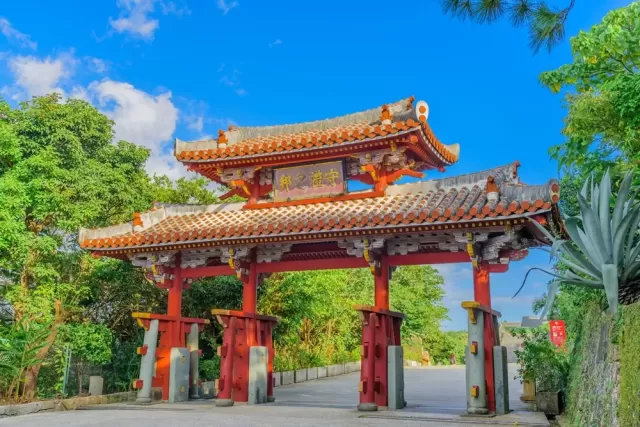
Sefa Utaki (斎場御嶽):
This sacred World Heritage Site is the spiritual center of the Ryukyu indigenous religion. Walk along wooded trails on a hill by the sea, past revered rock formations and natural "caves" where priests once prayed.
Opening hours: 9:00 - 18:00 (17:30 Nov-Feb). Don't forget to wear comfortable shoes. It's best to go on sunny days to admire a clear view of the sea from the sacred viewpoints.
Blue Cave (青の洞窟) - Onna:
Although technically on the midwest coast, it's a classic day trip from the south. Dive or snorkel in this cave illuminated by a magical blue glow (the sun reflecting off the white sand). Don't worry if you're inexperienced with these water activities; tours for beginners and non-swimmers are readily available.
Best time to visit: May to October for warmer, calmer waters. Book in advance during the summer!
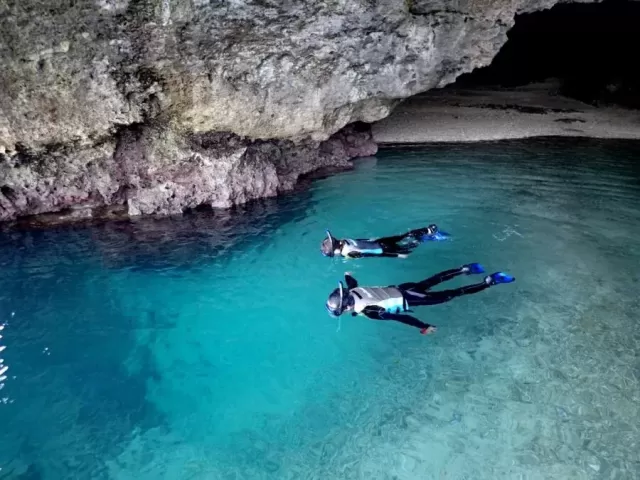
Glass Beach:
A poetic reminder of resilience. What was once trash (glass bottles) has been polished by the sea for decades, creating a unique beach covered in multicolored glass "stones." It's mesmerizing to watch them sparkle in the sun. Ideal for a short visit, collecting a few small pieces (remember, it's part of the ecosystem!), and reflecting. Free access.
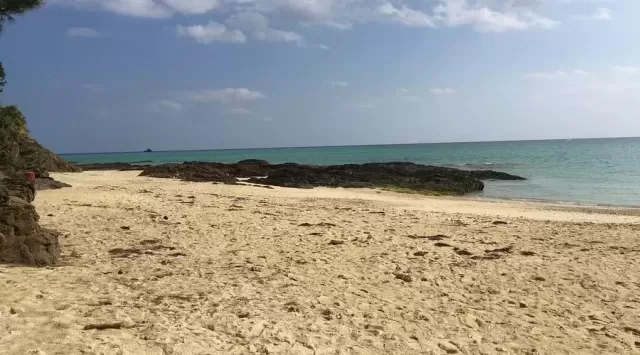
When to Visit Okinawa? Quick Guide
Best time to visit overall: October-November (autumn) and April-May (spring). Pleasant temperatures (20-28°C), less rain than in summer, and fewer tourists. Ideal for all kinds of activities.
Summer (June-August): Hot and humid (30°C+), strong sun, rainy season/possible typhoons (especially July-August), and VERY crowded (Japanese school holidays). Advantage: Warmer water for diving. If you go, arrive very early at popular spots, wear layers of good sunscreen, and book everything in advance.
Winter (Dec-Mar): Mild (15-20°C), little rain. Water is cooler for swimming (though possible if you're not too sensitive to low temperatures), but perfect for hiking, sightseeing, and avoiding crowds. The illuminated botanical gardens are a bonus.
Why should Okinawa be your next travel destination?
Okinawa is not just "another Japanese island." It's a world apart where time flows more slowly. It offers a winning combination:
- Lush Nature: Paradise beaches (Kouri, Sesoko), mysterious jungles (Hiji Falls), transparent waters (snorkeling, diving in Blue Cave) and unique formations (Heart Rock, Glass Beach).
- Living History and Culture: From the majestic Shuri Castle to the serene spirituality of Sefa Utaki, you will feel the legacy of the Ryukyu kingdom.
- Unique Experiences: Driving over the sea (Kaichu-doro), seeing giant whale sharks (Churaumi), walking under the sea (Busena), or exploring an American village in Asia (Mihama).
- Accessibility and Fun: Easy to get around by car, options suitable for all ages and interests (families at the aquarium, couples at Kouri, adventurers at the waterfalls, culture at Shuri).
- Diverse Gastronomy: Flavors distinct from the rest of Japan, with Okinawan pork, goya (bitter melon) and of course fresh seafood.
Okinawa is a fascinating gateway to Asia. It's safe, welcoming, full of contrasts, and brimming with human warmth. What are you waiting for? Start planning your next vacation now! Okinawa awaits.
